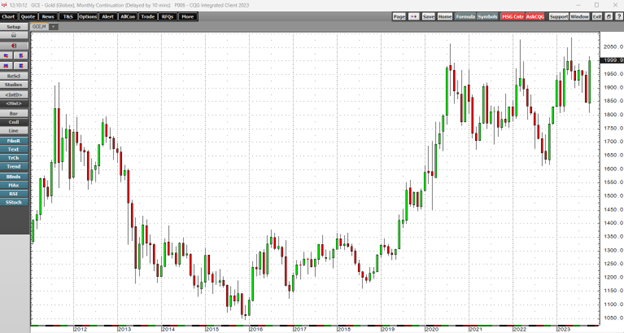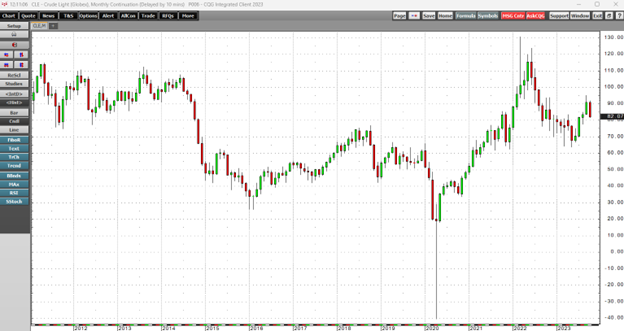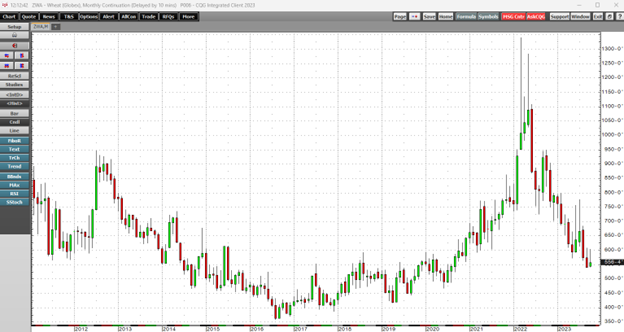Markets reflect the economic and geopolitical landscapes. In October 2023, elevated inflationary pressures and hawkish central bank monetary policies sent the short-term Fed Funds Rate from zero percent in March 2022 to 5.375% in early November 2023. Quantitative tightening to reduce the central bank's swollen balance sheet pushed interest rates higher further along the yield curve. In October 2023, the long bond futures fell to the lowest level since 2007, with mortgage rates rising to the 8% level.
While the economic environment creates uncertainty in markets across all asset classes, geopolitics have become downright dangerous.
War in Eastern Europe and the Middle East
The war in Ukraine is approaching its second anniversary. In February 2022, Chinese President Xi and Russian President Putin shook hands on a "no-limits" alliance. Less than one month later, Russian troops invaded Ukraine, and many political analysts believe it is only a matter of time until China forces reunification upon Taiwan. The alliance bifurcated the world's nuclear powers and made the geopolitical landscape dangerous, with the Bulletin of Atomic Scientists moving its Doomsday Clock to ninety seconds to midnights in early 2023.
On October 7, a horrendous terrorist attack in Israel caused the Israeli government to declare war on Hamas, the governing body in Gaza. Iran is attached to the Chinese-Russian alliance, and U.S. support for Israel has only widened the geopolitical gulf.
Gold takes off on the upside
The continuous COMEX gold futures contract reached $2,085.40 per ounce in May 2023, where it ran out of upside steam and corrected.

The monthly chart highlights gold's 11.6% rally from $1,809.40 on October 6 to $2,017.70. Gold put in a bullish key reversal pattern on the daily chart on October 6, the day before the terrorist attack in Israel, leading to the bullish key reversal pattern on the monthly chart in October. Gold's close above the $1,961.10 level on October 31 established the bullish technical formation.
Crude oil and wheat in the crosshairs
While gold has taken off on the upside and could be heading for a new all-time peak, crude oil and wheat prices remain far below the 2022 highs. Crude oil and wheat are critical commodities to watch over the coming weeks and months. Crude oil is always highly sensitive to events in the Middle East, as OPEC and Russia control global prices. Russia is the world's leading wheat-exporting country, and wheat is the staple that is the primary ingredient in the bread that feeds the world.

The monthly NYMEX crude oil futures chart shows the rally that took the energy commodity to the highest price since 2008 at $130.50 per barrel in March 2022. Crude oil futures corrected 51.2% to a $63.64 low in May 23 before recovering to just over the $95 per barrel level. Seasonality and global economic concerns have pushed oil prices lower, but they remained above the $80 per barrel level at the end of October. Meanwhile, the U.S. Strategic Petroleum Reserve is at its lowest level in four decades. If oil prices drop further, the U.S. will purchase barrels to replace its SPR, supporting prices. Moreover, with OPEC+ controlling oil prices, Russia using traditional energy as an economic weapon against "unfriendly" countries supporting Ukraine, and the potential for an escalating war in the Middle East, the odds favor higher oil prices over the coming months.
In its October World Agricultural Supply and Demand Estimates Report, the U.S. Department of Agriculture told the wheat market, "The outlook for 2023/24 U.S. wheat this month is for higher supplies, increased domestic use, unchanged exports, and higher ending stocks." However, the worldwide supply picture reflects falling supplies. The USDA said, "Projected 2023/24 global ending stocks are lowered 0.5 million tons to 258.1 million, the lowest since 2015/16." Falling global stocks with Russia, the leading exporter, is a clear and present danger for the global wheat market.

The chart shows that CBOT soft red winter wheat futures rose to a record $14.2525 per bushel in March 2022. Ample supplies during the 2023 harvest pushed the price to a $5.40 low in September. However, with Russia and Ukraine at war and the Black Sea Ports, a critical logistical hub, the potential for another rally is high in 2024.
The bottom line is the geopolitical landscape will continue to impact gold, crude oil, and wheat futures markets over the coming months. If gold's recent rally to over $2,000 per ounce is a precursor, we could see significant rallies in the oil and wheat futures arenas.
Stocks and bonds under pressure
Rising interest rates have pressured the U.S. government bond market. However, selling from China and the potential for a BRICS currency with gold backing to challenge the U.S. dollar's reserve currency role have added to the bearish sentiment.

The quarterly chart of the U.S. 30-year Treasury Bond Futures illustrates the bearish trend since the 2020 high. In October 2023, the long bond futures fell to 107-04, the lowest level since 2007, putting pressure on stocks.

The monthly chart of the SPY ETF that tracks the most diversified U.S. stock market index, the S&P 500, shows the developing pattern of lower highs since the early 2022 record peak. The S&P 500 peaked at a lower high in July 2023, posting consecutive declines over the past three months.
Expect the unexpected
War is hell, and two significant conflicts are raging in Europe and the Middle East. The chances of an escalation remain high with the bifurcation of the world's nuclear powers. Meanwhile, the Fed's hawkish monetary policies have reduced inflation, but the central bank's 2% target has become an unrealistic target, given the impact of geopolitics on prices. Markets will likely be volatile as economic and political uncertainty are at the highest levels in many decades.
The October 7 terrorist attack shocked the world. Unexpected events often have the most dramatic impact on markets. Investors and traders need to prepare for the unexpected as the norms of yesteryear and historical correlations may not repeat in the current environment. Risk-reward dynamics and discipline are critical factors for success as we move into the final months of 2023 and the year ahead in 2024. Prepare for rising or spiking volatility to avoid unpleasant surprises.